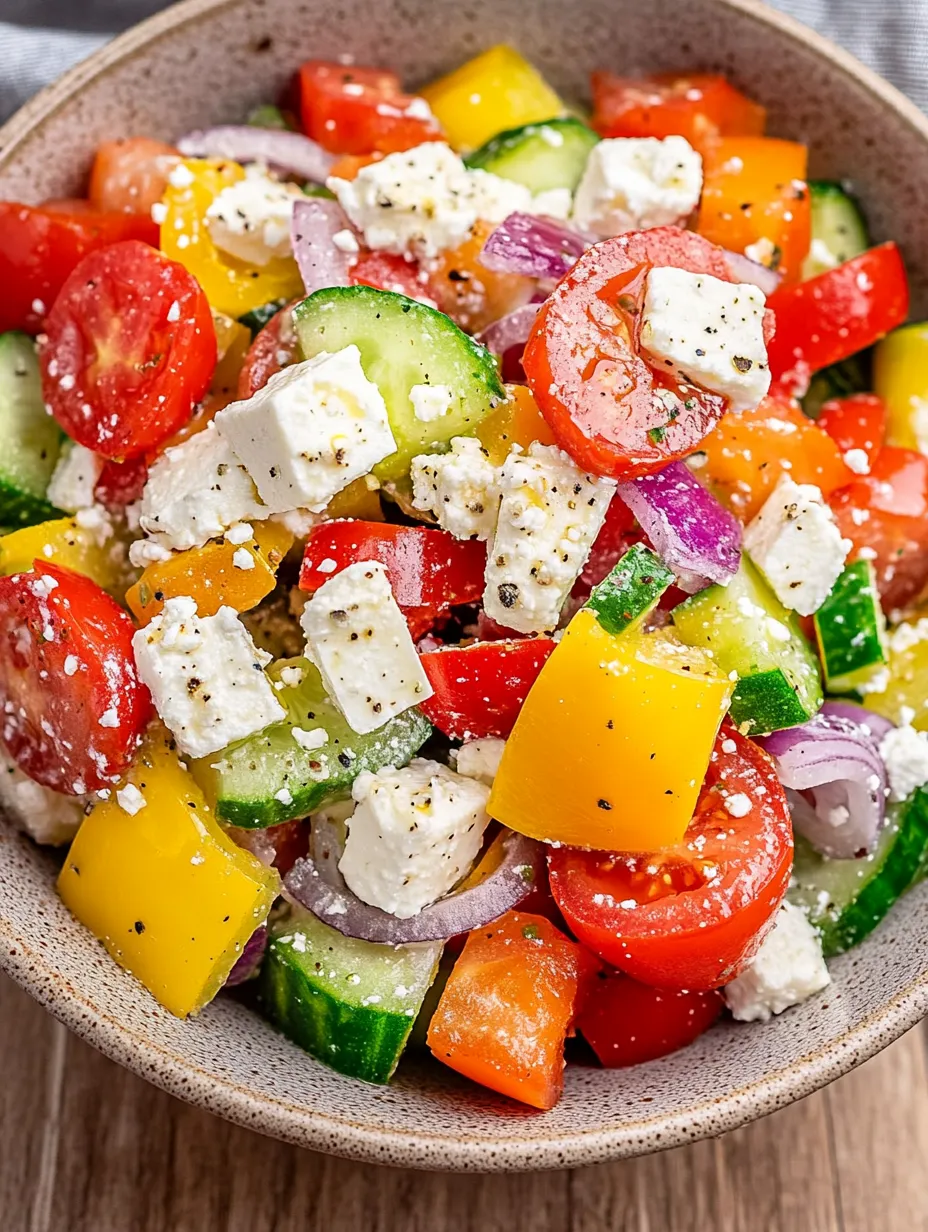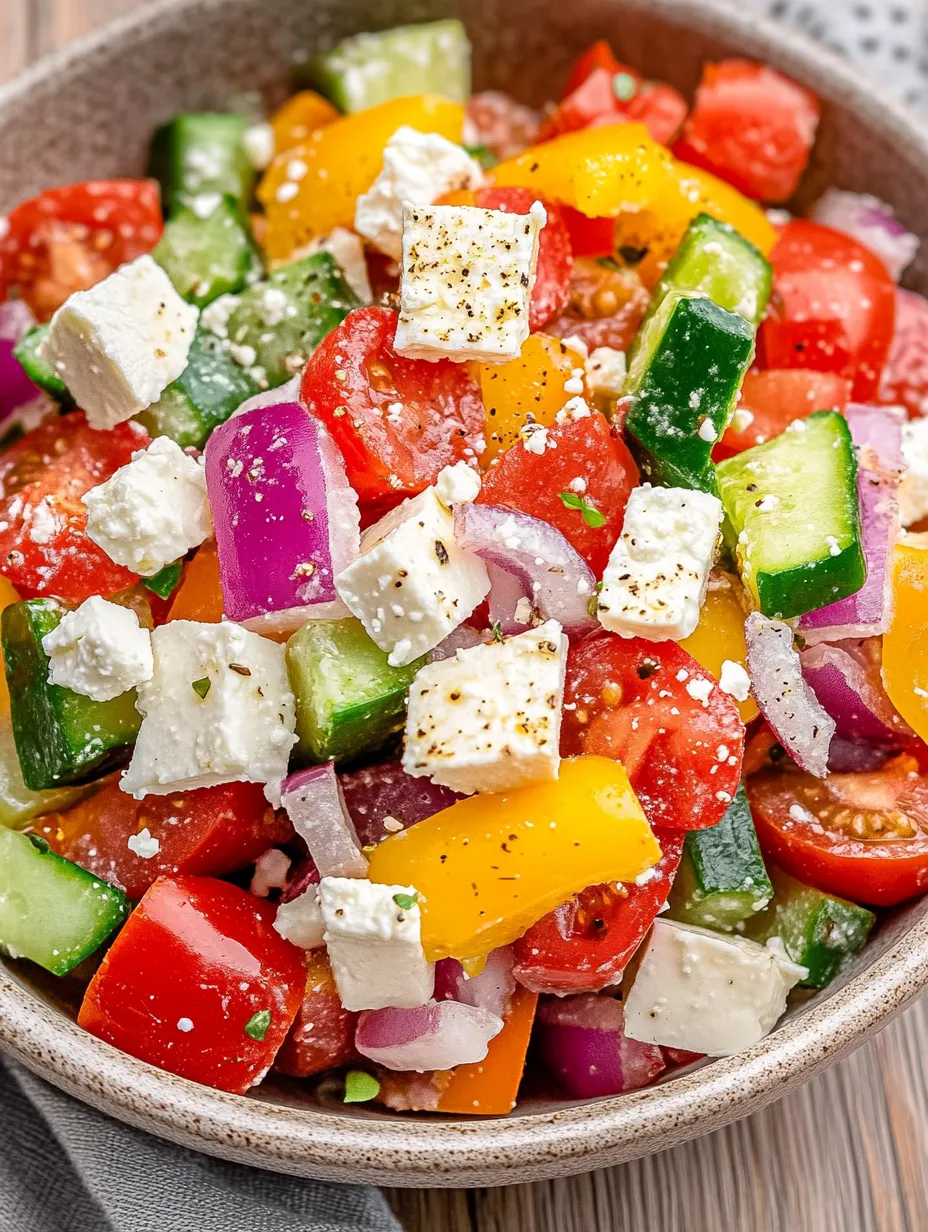 Pin it
Pin it
This Greek farmer's salad, also known as "Choriatiki", is a prime example of Mediterranean cuisine with its simplicity and freshness. The roughly cut vegetable pieces and the savory feta create a hearty, satisfying dish that convinces both as a side dish and as a light main meal.
When I tried this salad for the first time in Greece, I was delighted by the intensity of the flavors and the simplicity of preparation. The sun-ripened tomatoes, the crisp cucumber, and the salty feta complement each other perfectly to create a taste experience that brings summer to your plate.
Main Ingredients
- Tomatoes: Form the juicy base of the salad and should be fully ripe and aromatic
- Cucumber: Provides freshness and a crisp bite
- Bell pepper: Brings sweetness and an additional texture into play
- Red onion: Gives the salad a mild sharpness and a splash of color
- Feta: The star of the salad with its creamy texture and salty taste
 Pin it
Pin it
Detailed Preparation
- Optimally prepare vegetables
- Thoroughly wash the cucumber and halve it lengthwise. For organic cucumbers, the skin can stay on, otherwise possibly peel. Cut the cucumber halves into half-moons about 1 cm thick. Wash the vine tomatoes and remove the hard stalk at the stem. Halve the tomatoes and then halve again, resulting in rough quarters. Wash the bell pepper, halve it, remove the stem and seeds, and cut into pieces about 2 cm in size. Peel the red onion, halve it, and cut into thin half-rings. It's important that all vegetable pieces remain relatively coarse – this is characteristic of an authentic Greek farmer's salad and ensures that the vegetables maintain their texture.
- Properly cube feta
- Remove the feta from the packaging and drain. Cut into rough cubes of about 1-2 cm with a sharp knife. Traditionally, the feta is not crumbled but placed on the salad in cubes or even as a whole piece. This preserves the creamy consistency and the full flavor.
- Assemble salad
- Use a large, flat salad bowl so the vegetables don't lie too close together. Add the prepared vegetables – cucumber, tomatoes, bell pepper, and onions – to the bowl. Distribute the feta cubes on top, do not mix in. Sprinkle generously with the dried oregano so that the characteristic aroma of the herb is present throughout the salad. If using olives, add them now.
- Prepare dressing and arrange
- For the dressing, freshly squeeze the lemon juice. In a small bowl, whisk the oil with the lemon juice, a pinch of salt, and freshly ground pepper. The dressing should not be emulsified, but simply mixed. Drizzle the finished dressing evenly over the salad. Stir the salad very carefully and minimally so that the vegetable pieces maintain their shape and the feta doesn't fall apart. Traditionally, the salad is not mixed at all, but the dressing is simply poured over it.
I have found that this salad tastes especially good when I prepare it about 10-15 minutes before serving and let it sit. This allows the flavors to combine without the vegetables becoming too soft. Particularly important is the quality of the tomatoes – they should be fully ripe and aromatic, as they give the salad a lot of flavor.
Mediterranean Classic
The Greek farmer's salad, known in Greece as "Choriatiki", is a prime example of Mediterranean cuisine with its emphasis on fresh, seasonal ingredients. Originally enjoyed by Greek farmers as a nutritious meal during work in the fields, this salad has developed into an international favorite. The simplicity of preparation and the quality of ingredients are in the foreground – a philosophy that permeates the entire Greek cuisine. In the traditional version, the salad is served without any leafy greens, which distinguishes it from many Western interpretations.
Serving Suggestions
This versatile salad harmonizes with various dishes:
- As a classic side dish to grilled meat or fish
- With fresh flatbread and tzatziki for a light dinner
- As part of a mezze platter with hummus, olives, and stuffed grape leaves
- In summer with a glass of chilled white wine as a refreshing meal
Variation Possibilities
The basic recipe can be creatively modified:
- For more color and flavor, combine different colored bell peppers
- For additional texture, add roasted pine nuts or walnuts
- For a sharper note, add finely chopped garlic to the dressing
- For a more complete dish, mix in cooked, cooled potato cubes
 Pin it
Pin it
Storage
The Greek farmer's salad tastes best freshly prepared. If needed, it can be stored covered in the refrigerator for about 4-6 hours. The tomatoes release more juice over time, making the salad more watery, and the feta can lose its firm consistency. For optimal enjoyment, the salad should therefore be consumed on the day of preparation.
After numerous preparations of this salad, both in Greece and at home, I can say that the secret lies in the simplicity and quality of the ingredients. A good Greek farmer's salad needs no complicated preparation or exotic spices – it delights through the freshness of the vegetables, the creaminess of the feta, and the harmonious interplay of all components. It is a perfect example of how a few, high-quality ingredients can result in a truly delicious dish.
Frequently Asked Questions
- → Which oil is best for a Greek salad?
- Traditionally, high-quality extra virgin olive oil is used for Greek salad, giving it an authentic Mediterranean flavor. If you don't like olive oil, you can also use mild canola oil.
- → Is Greek salad always vegetarian?
- Yes, the classic Greek village salad (Choriatiki) is vegetarian, but not vegan, as it contains feta cheese. For a vegan version, you can replace the feta with a plant-based alternative.
- → Can I prepare the salad in advance?
- The salad tastes best freshly prepared. However, you can cut the vegetables a few hours ahead and refrigerate them. Add dressing and feta just before serving to keep the salad crisp and the feta at its best texture.
- → What are typical side dishes to serve with Greek salad?
- Greek salad pairs excellently with grilled meat or fish, gyros, souvlaki, or other Mediterranean dishes. It also makes a complete meal when served with fresh flatbread or pita and a light garlic sauce (tzatziki).
- → Which olives work best in the salad?
- Traditionally, black Kalamata olives are used as they have an intense, savory flavor. However, you can also use green olives or a mix, depending on your personal preference.
- → Are there variations of the classic recipe?
- In different regions of Greece and on the islands, there are slight variations. Some add capers, green peppers, chili peppers, or even anchovies. However, an authentic Greek village salad never contains leaf lettuce such as iceberg or romaine.
